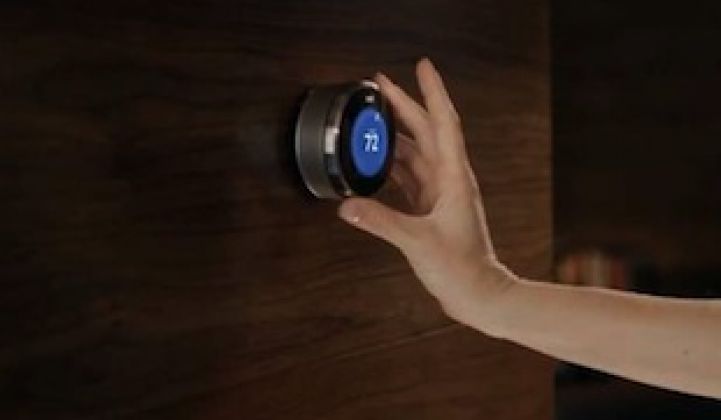Last spring, Nest unveiled its version of residential demand response known as Rush Hour Rewards. The offering, which fine-tunes the thermostat settings to cut energy use during peak demand days, was picked up by various big-name utilities.
The results of that first year are in, and the programs are generally successful, but do not blow the competition out of the water. For each event, Nest announced that the AC load was cut an average of 55 percent.
That sounds huge, but it equals about 1.18 kilowatts per device. If there is one thermostat enrolled in a home, the energy reduction is not out of the ordinary for similar programs. A savings of about 1 kilowatt to 1.3 kilowatts per home is the industry standard for residential demand response programs. Oklahoma Gas & Electric, by comparison, has been able to get that number to nearly 2 kilowatts per home across tens of thousands of customers.
Of course, the name of the game these days is getting the kilowatt savings while keeping people happy. Nest, along with some other competitors, does that successfully by fine-tuning AC settings and subtly precooling homes so that residents do not feel a temperature spike during the peak event, which is usually two or four hours in duration.
“In fact, 84 percent of customers who participated in Rush Hour Rewards and 89 percent of customers who participated in Seasonal Savings told us they were just as comfortable as they were before they participated in our energy service programs,” Tony Fadell, Nest founder and CEO, said in a statement. “This is critical to the adoption and ultimate success of these programs.”
For this season, Nest is adding in a new instant offering to its Rush Hour Rewards, via which utilities can let residential customers know just 10 minutes before an event that they will adjust their thermostats. Nest also announced the results of its Seasonal Savings offering, which automatically adjusts thermostats over a few weeks as seasonal changes occur.
The shifts resulted in an average 4.7 percent reduction in AC runtime. For this season, the shifts will be customized based on personal preferences and weather profiles, rather than starting on set days.
The findings from the first year of Rush Hour Rewards and Seasonal Savings show that Nest will continue to be another popular player in energy efficiency and customer acquisition programs, as well as the bring-your-own-thermostat programs that are proliferating in the U.S.
Although the energy savings during demand response events may be in line with other offerings, the appeal of Nest continues to outstrip the competition. Nest, which was bought by Google for $3.2 billion earlier this year, also announced five new utility customers: npower in the U.K., Columbia Gas of Ohio, ComEd, CPS Energy and Direct Energy in the U.S. The new utility customers join more than a dozen existing utility clients in the U.S. and Canada.
Some new utility customers will use Nest as part of their energy efficiency programs, offering rebates to cover some of the cost of the $249 thermostat, while others will offer them to entice people into demand response programs. ComEd, which serves nearly 4 million customers, will offer a $140 rebate for customers that participate in Rush Hour Rewards.
Across the pond, RWE’s npower will offer customers a Nest learning thermostat for £99 ($166), which retails for £279 ($468). In the deregulated U.K. market, offering a Nest thermostat is more about customer retention than enrolling customers into demand response programs.
Even in the U.S., offering a Nest device is increasingly about giving customers something they want, rather than just rebates for bland energy efficiency products that are the equivalent of being told to eat your vegetables.
The sexy Nest thermostat is about home automation, not just energy services, which is why Google paid a premium for the company. But buried in home automation is an important place for energy services, and more and more utilities are beginning to understand that is where their future is headed.



